Are you ready to dive into the enchanting world of grey animals? Prepare to be captivated by these 12 fascinating creatures, each with their own unique charm and beauty. From the majestic Elephants, the true grey giants of the animal kingdom, to the agile climbers like the Gray Squirrel, these animals will leave you in awe. And if you thought grey was a dull color, think again! The Gray-headed Flying Fox will prove that grey can be absolutely stunning, especially when it comes to large-winged bats. So, grab your binoculars and get ready to explore the grey side of nature with these captivating pictures of 12 fascinating grey animals.
1. Elephants: The Grey Giants
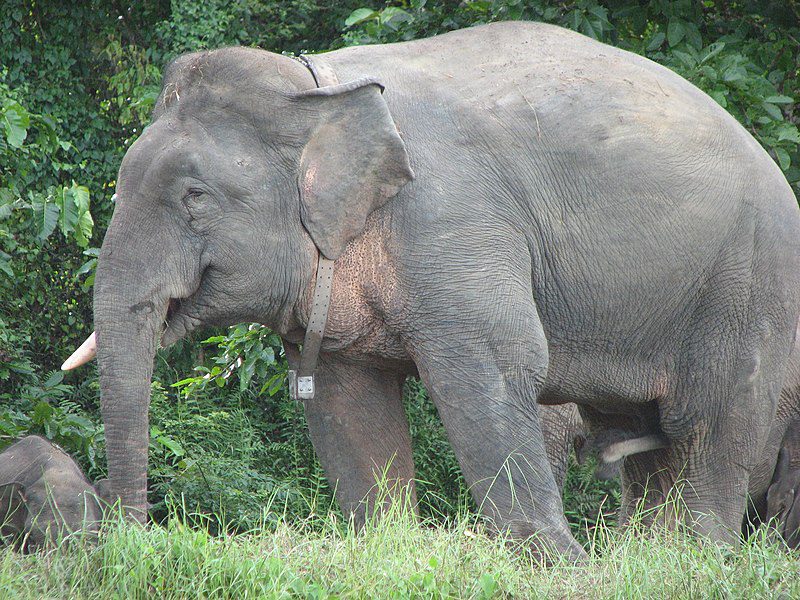
elephants
When it comes to the quintessence of grey animals, the majestic Elephants often strike our minds first. These awe-inspiring, colossal creatures, adorned with their large size and characteristic grey skin, are undoubtedly among the most iconic grey animals that grace our planet.
The largest land mammal on Earth, the African Bush Elephant, proudly flaunts a greyish-brown skin, a coloration that merges seamlessly with the savannas and woodlands they inhabit. This intelligent giant is a masterpiece of nature’s canvas, intricately designed for survival in the wild, and a testament to the fascinating diversity of the animal kingdom.
Did you know? The African Bush Elephant, the largest land mammal, has a unique greyish-brown skin that camouflages it in the savannas and woodlands!
Their large, fan-like ears, a distinctive feature, serve more than just an aesthetic purpose. They are an effective cooling mechanism that helps dissipate heat, providing much-needed relief in the harsh African heat. The long, curved tusks, another striking feature, are not just for show. They are versatile tools used for foraging, digging for water, and as formidable weapons in fights. As herbivores, these grey giants have a diverse diet, munching on everything from grass to fruit, bark, and leaves.
| Characteristic | Description |
|---|---|
| Size | Largest land mammal |
| Skin color | Greyish-brown |
| Habitat | Savannas and woodlands |
| Diet | Grass, fruit, bark, and leaves |
| Tusks usage | Foraging, digging for water, and fighting |
| Ears function | Dissipate heat |
Not just a spectacle of beauty and power, Elephants are a keystone species, playing a pivotal role in shaping their environment. Their feeding habits help control vegetation, and their droppings contribute to biodiversity by dispersing seeds. However, these majestic creatures face significant threats from habitat loss and ivory poaching. Their survival is crucial, not just for their species, but also for the ecosystems they inhabit and the biodiversity they help sustain.
As we journey through the fascinating world of grey animals, there is no better start than with these magnificent, grey giants. So, let’s continue to marvel at the wonders of nature as we delve into the lives of more fascinating grey creatures in our lineup.
2. Gray Wolf: The Social Predator
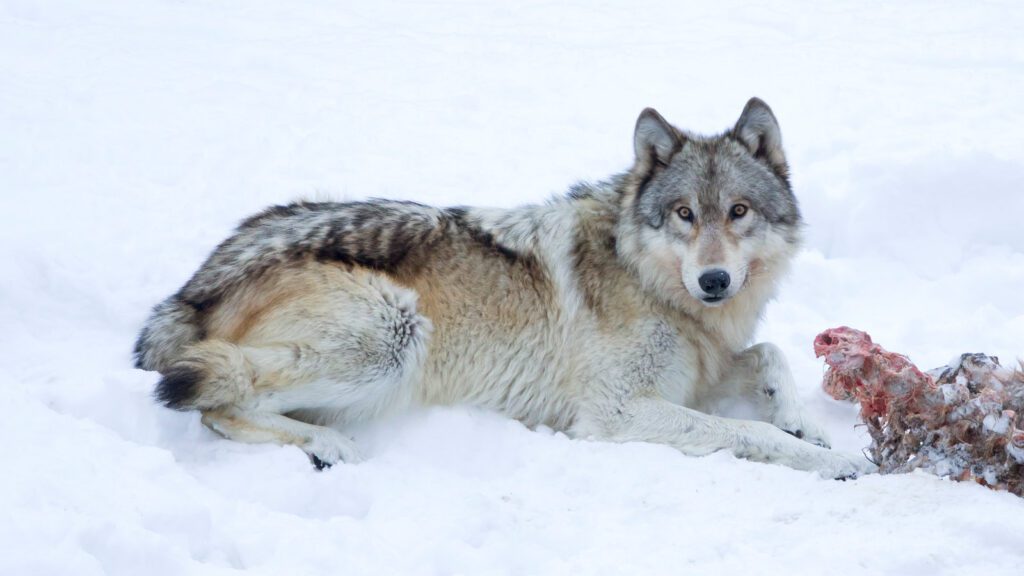
gray wolf
The Gray Wolf, scientifically known as Canis lupus, is a creature steeped in folklore and history, captivating human imagination with its enchanting mix of fear and respect. Striding through the wild terrains of North America, Europe, and Asia, the Gray Wolf is a testament to nature’s raw power and intelligence.
However, the term “grey wolf” is more of a species identification, and less about their actual color. The wolf’s dense fur coat, a shield against harsh winters, can take on a spectrum of colors, from the purity of white, through a symphony of browns and greys, to the mystery of deep, solid black. This natural color palette not only enhances their aesthetic appeal but also aids in their survival, allowing them to blend seamlessly into their environment – a perfect example of nature’s camouflage at its finest.
But what truly sets the Gray Wolf apart is its sophisticated social structure. Wolves are not solitary predators but social creatures who thrive in the company of their kind. They live in packs, intricate webs of relationships and hierarchies, each wolf playing a specific role. From the alpha pair that leads the pack with wisdom and strength, to the playful juveniles and pups, every member has a crucial part to play in the survival and success of the pack.
“Wolves communicate through a complex language of howls, body postures, and scent marking, painting a vivid picture of their emotions, intentions, and messages for others in the pack.”
This intricate communication system, a testament to their intelligence, is one of the reasons humans have been both intrigued and terrified of these magnificent creatures for centuries. As we delve deeper into the fascinating world of these gray animals, we find that each species, from the mighty elephant to the graceful wolf, contributes uniquely to the rich tapestry of life on Earth.
3. Gray Whale: The Long-distance Migrant
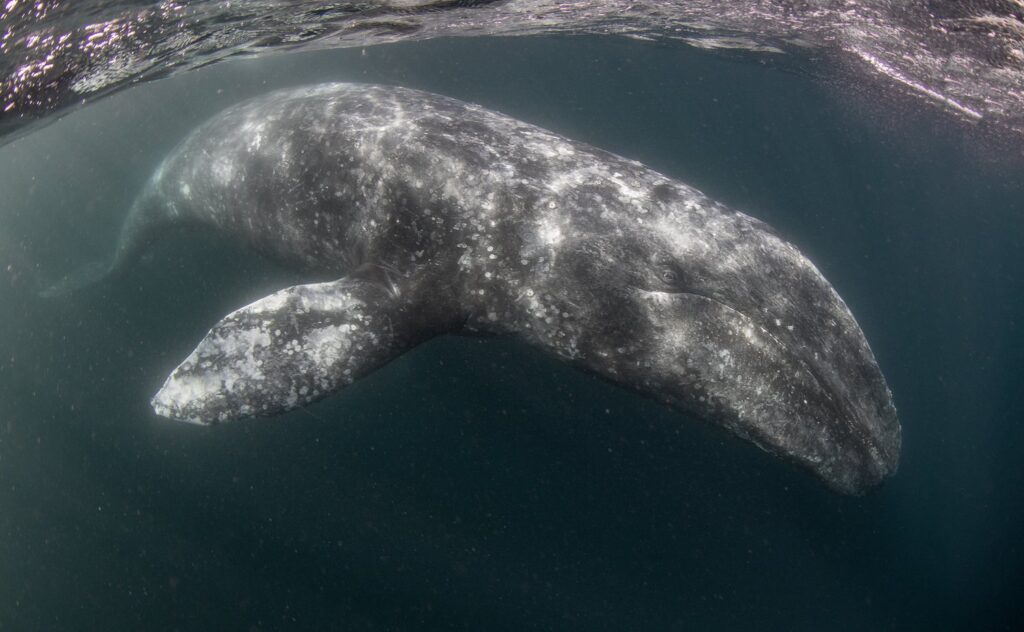
gray whale
Emerging from the frigid waves of the Arctic, the Gray Whale is a magnificent marine marvel recognized by its distinct mottled grey hue. These aquatic giants hold the title for one of the longest migrations of any mammal, an incredible journey that spans up to 12,000 miles round trip. This marathon of migration, a testament to their strength and stamina, takes them from their Arctic feeding grounds to the warmer breeding lagoons of Baja California, Mexico.
But their fascinating traits do not end at their extensive travels. Gray Whales are known as “bottom feeders,” a term that describes their unique feeding technique. Just imagine, these massive creatures delicately turning on their sides to scoop up sediments from the seafloor. Using their baleen, a comb-like structure in their mouths, they filter out tiny crustaceans and other minute marine morsels, making a meal out of what seems like mere marine mud to us.
Check out: Are Hawks Friendly? Discover the Surprising Truth and Find Out if You Can Keep Hawks as Pets
Scientifically known as Eschrichtius robustus, their bodies are a canvas of dark skin, overlaid with patches of lighter, barnacle-covered skin, often dotted with lice. This pattern of barnacles and lice is as unique to each whale as fingerprints are to humans. So, even amidst the vastness of the Pacific Ocean, each Gray Whale carries its own distinct identity.
As we dive deeper into the world of the Gray Whale, we realize that they are more than just fascinating creatures. They are ambassadors of the majestic marine life, a testament to the wonders of wildlife, and a stark reminder of the urgent need for conservation in this ever-changing world.
4. Koala: The Sleepy Marsupial
As we leave the ocean depths inhabited by the Gray Whale and tread into the lush eucalyptus forests of Australia, we encounter the endearing and enigmatic Koala. Their round, grey bodies, white tufts in their ears, and a spoon-shaped nose often lead to them being mistaken for bears. However, they are actually marsupials, sharing a closer kinship with kangaroos and wombats.
Decked in a coat of grey fur, these marsupials have brilliantly adapted to their eucalyptus-rich habitat. This fur not only provides warmth in the chilly Australian winters but also serves as an impeccable camouflage against the eucalyptus tree bark. This fur, varying from silver grey to chocolate brown, is an excellent example of how animals evolve to blend into their environments.
Fur, a fundamental aspect of a Koala’s identity, is a testament to the marvel of evolutionary adaptation, as it not only keeps them warm but also helps them stay hidden from predators.
Leading a slow-paced life, Koalas spend a staggering 18-20 hours a day sleeping. Their nutrient-poor diet of eucalyptus leaves demands conservation of energy. It’s a lifestyle that may seem enviable to some, but like all creatures in the animal kingdom, the Koala too faces its share of hardships.
Despite their sleepy demeanor, Koalas grapple with many threats, including habitat destruction, climate change, and disease. These challenges have led to a significant decline in their populations, illuminating the urgent need for concerted conservation efforts.
As a symbol of Australia’s unique wildlife, the Koala underscores the critical importance of protecting our planet’s biodiversity. Their survival hinges not just on the conservation of the eucalyptus forests they call home, but also on our collective efforts to mitigate climate change and prevent disease outbreaks.
As we tread further into our journey of exploring fascinating grey animals, the Koala serves as a poignant reminder that these creatures’ survival is intrinsically linked with the health of their habitats and our planet at large.
5. Gray Squirrel: The Agile Climber
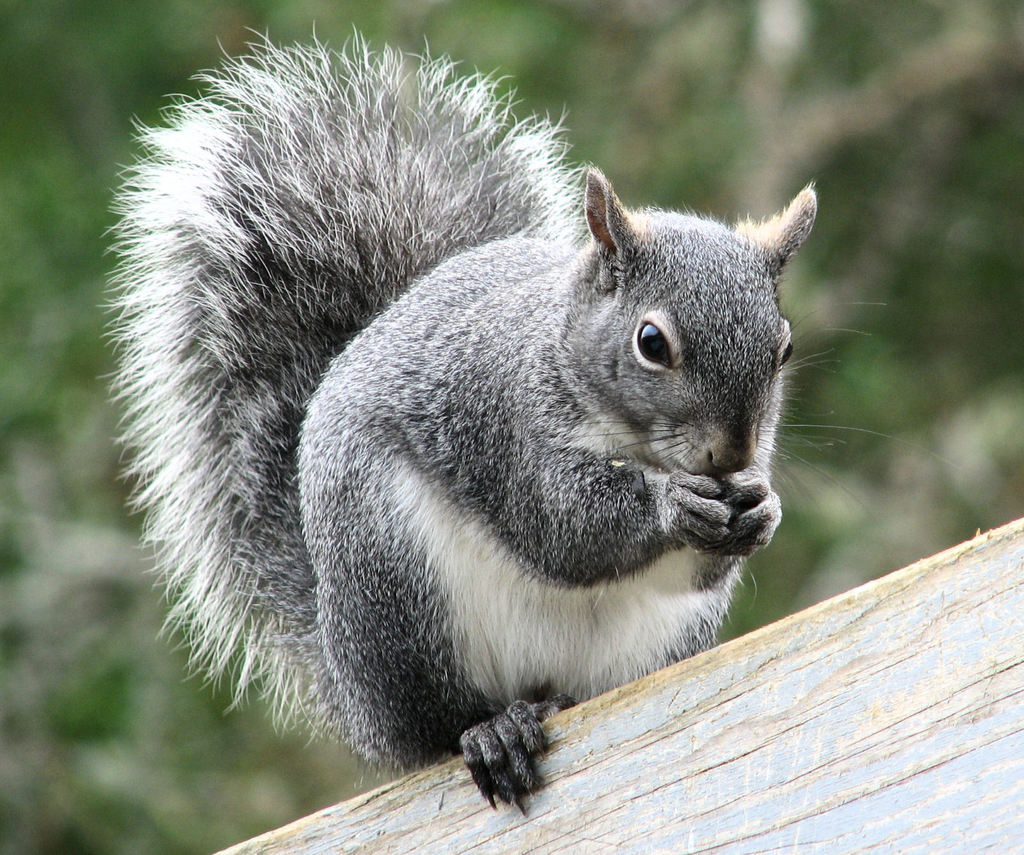
gray squirrel
As we shift our gaze from the vast oceans and the arid landscapes of Australia, our journey brings us closer to home, to the humble parks and verdant forests. Here, we encounter the nimble and agile Gray Squirrel, a creature as common as it is captivating.
Adorned with a sleek silvery-gray coat, the Gray Squirrel is a master of camouflage. Just as the Gray Whale blends with the ocean depths and the Koala disappears amidst eucalyptus leaves, the Gray Squirrel’s fur mirrors the color of tree bark, providing them with a natural invisibility cloak against predators.
But it is not their color that makes them stand out in the world of grey animals; it is their astonishing agility. Imagine a professional gymnast performing a flawless routine, only, in this case, the gymnast is a squirrel, and the stage is the complex network of tree branches!
These creatures are synonymous with speed and precision. They can dart up and down trees with an elegance and speed that would make even the most accomplished acrobats green with envy. This acrobatic prowess, coupled with their keen sense of direction, allows them to navigate effortlessly through dense forests and urban parks. It’s a sight that never ceases to amaze, whether you’re witnessing it for the first time or the hundredth.
So, the next time you’re out for a walk in the park, pause for a moment. Look up at the trees, and you might just spot one of these agile climbers darting deftly from branch to branch. The Gray Squirrel, with its playful antics and swift movements, serves as a reminder of the beauty and grace hidden in our everyday surroundings.
6. Gray Fox: The Elusive Tree-Climbing Canid
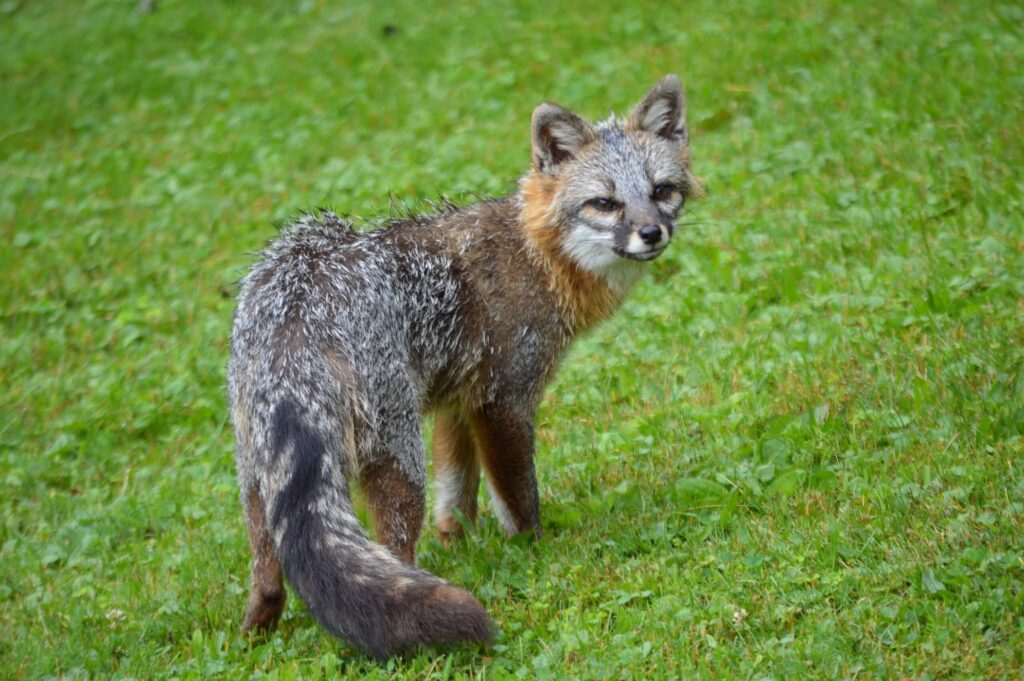
gray fox
If you thought climbing trees was a skill reserved for felines or primates, allow me to introduce you to the Gray Fox. A creature of remarkable versatility, this small carnivorous mammal is native to the diverse landscapes of North and Central America.
This canid is a master of camouflage, donning grizzled grey fur peppered with patches of cinnamon, white, and black. This color palette allows the Gray Fox to remain virtually invisible in a variety of habitats, from woodland thickets to rocky terrain. It’s a fascinating testament to nature’s ability to engineer survival strategies.
“The Gray Fox – a unique member of the dog family, has the uncanny ability to climb trees. Its strong, hooked claws are not just for show, they serve a vital purpose in this creature’s arboreal adventures.”
While their tree-climbing prowess sets them apart from most canids, it’s not the only unique aspect of their lifestyle. They are opportunistic feeders, with an omnivorous diet that includes small mammals, birds, insects, and a surprising variety of fruits. This dietary diversity helps them adapt to different environments and seasons, making them resourceful survivors.
Stealthy, agile, and solitary, the Gray Fox leads a life that is as intriguing as it is elusive. They spend much of their time alone, with their social interactions largely confined to the mating season. This solitary nature, coupled with their cryptic coloration, makes spotting a Gray Fox in the wild a truly special experience.
Our journey into the world of grey animals has taken us from the vast savannahs inhabited by elephants, to the sleepy treetops of koalas, and now to the secret hideaways of the Gray Fox. As we continue our exploration, let’s appreciate the incredible diversity and adaptability these creatures showcase, reminding us of the wonders nature holds.
Gray Fox Quick Facts:
- Scientific Name: Urocyon cinereoargenteus
- Type of Animal: Mammal
- Where Found: North and Central America
- Unique Trait: Ability to climb trees
- Diet: Omnivorous (small mammals, birds, insects, fruits)
7. Gray Langur: The Expressive Primate
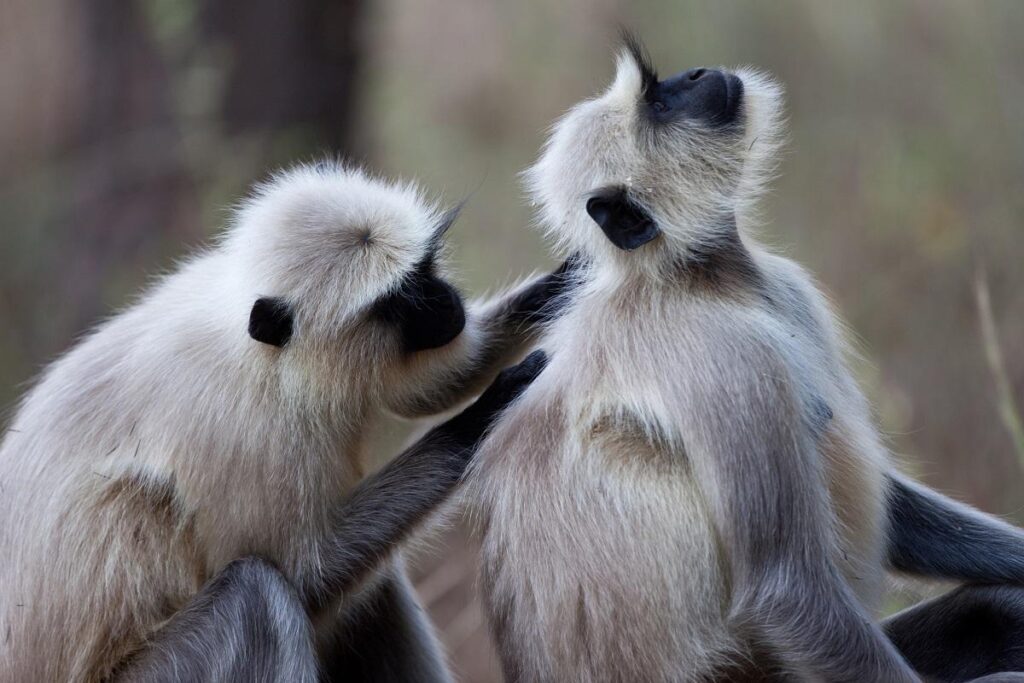
gray langur
As we journey deeper into the world of gray animals, we encounter a creature that is a true embodiment of social interaction and fascinating behavior—the Gray Langur. Also known as Hanuman langurs, these primates are native to the lush forests and rugged terrains of South Asia. Their distinctive gray fur, which gives them their name, is complemented by a captivating display of expressive facial features that convey a range of emotions.
Gray Langurs are intelligent and agile creatures, often seen frolicking in large, harmonious troops. Like a well-rehearsed orchestra, they move in perfect synchronization, leaping agilely from tree to tree, their strong, slender limbs propelling them through the thick foliage of their forest homes. This agility, a common trait in our gray animal compatriots, is a testament to their adaptability and survival skills.
In the quiet solitude of the forest, their distinctive whooping calls pierce the silence, reverberating through the dense canopy like a symphony of nature. This chorus of whoops and hoots is their unique way of communicating, signaling their presence to others within their troop and asserting their territory.
Read more: What Eats Octopus? Discover the Top 12 Predators That Feast on These Clever Cephalopods!
The Gray Langur, with its expressive demeanor and engaging social behavior, serves as a potent reminder of the rich biodiversity that exists within our world. Each call, each leap, and each interaction adds a new layer to the intricate tapestry of life in the forest, offering us a glimpse into the fascinating world of these gray-coated primates.
Remember: Like the Gray Squirrel and the Gray Fox, the Gray Langur is another exemplar of agility and adaptability in the animal kingdom. Each creature, in its own unique way, contributes to the vivid palette of nature’s colors.
8. Gray Heron: The Wetland Hunter
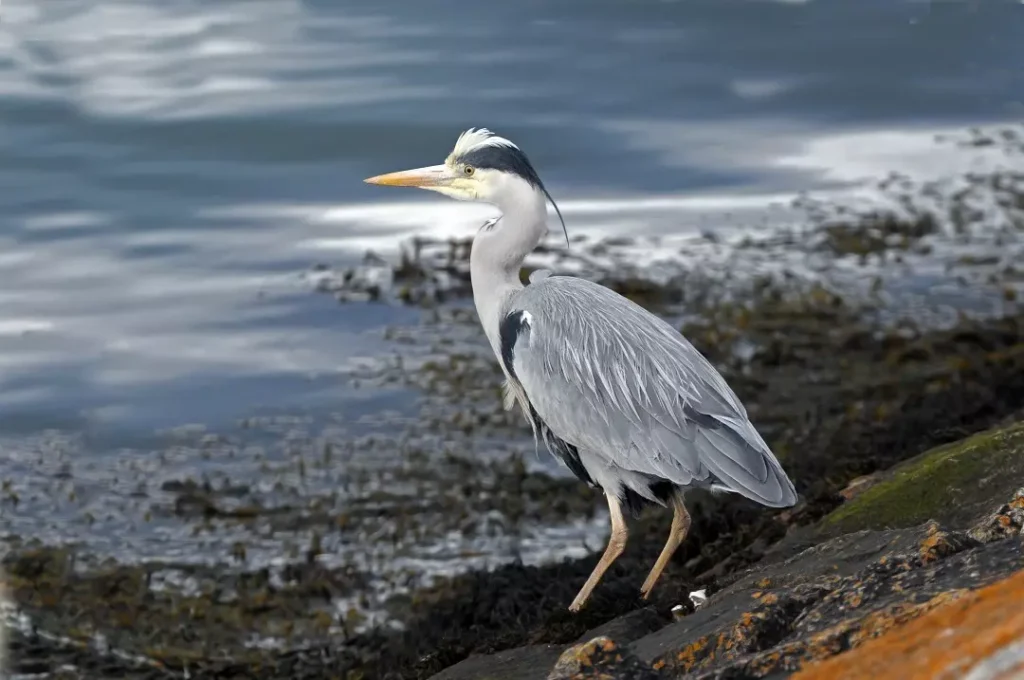
gray heron
Emerging from the realm of wetlands, the Gray Heron, with its majestic grey plumage, stands as a testament to the remarkable adaptability of avian species. As spectators, we often get mesmerized by the heron’s unique hunting style, a mix of patience and agility reminiscent of a skilled warrior.
Imagine standing on the banks of a tranquil wetland, your eyes scanning the serene landscape. Suddenly, a tall, statuesque bird catches your attention. Its long, sinewy neck tapers into a sharp beak, perfect for striking unsuspecting prey. This is the Gray Heron, a master of stealth and patience.
“The Gray Heron is a solitary hunter, often seen standing motionless at the water’s edge, its keen eyes focused on the depths below. It waits, poised and ready, embodying the adage that patience is truly a virtue.”
When a fish comes within striking distance, the heron’s game of patience ends. In a flash, it lunges forward, its beak piercing the water’s surface with lightning speed. The heron’s sharp beak, acting as an efficient spear, impales its prey, making escape virtually impossible.
The Gray Heron is not just a hunter, but an integral part of the wetland ecosystem. Its hunting activity controls the population of small aquatic animals, maintaining a balanced biodiversity. This fascinating bird, with its grey plumage blending seamlessly with the wetland backdrop, is truly a sight to behold, a living demonstration of nature’s grand design.
Let us continue our journey, as we dive deeper into the world of grey animals, each unique, each playing a vital role in the delicate balance of nature.
9. Gray Seal: The Agile Swimmer of the North Atlantic
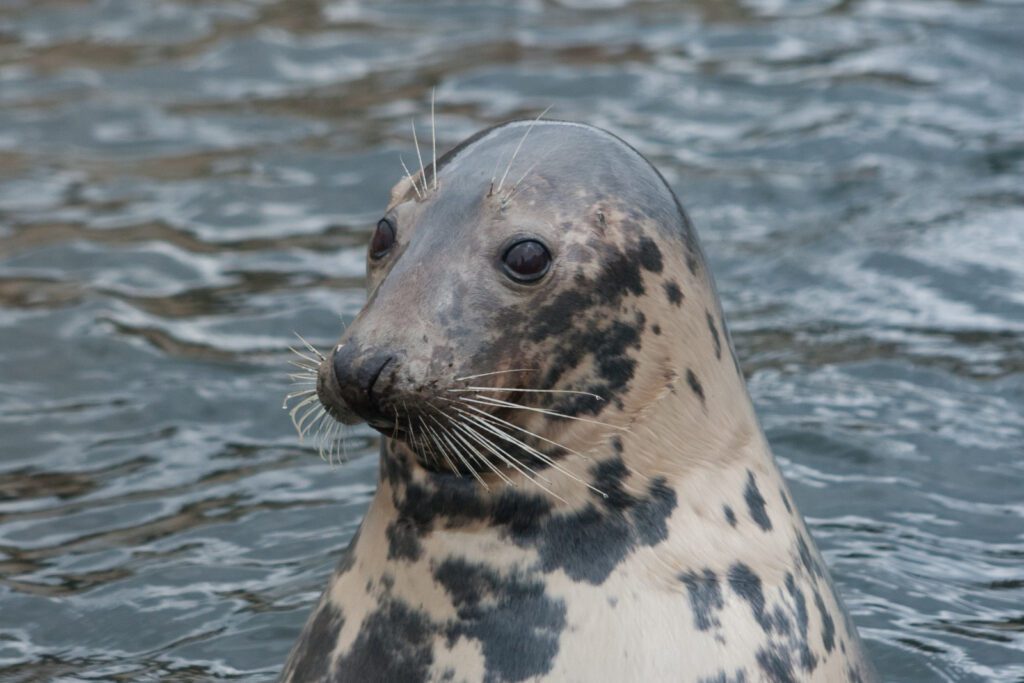
gray seal
As we return to the ocean’s embrace, our journey introduces us to the charming Gray Seal, an enchanting marine mammal that calls the cold waters of the North Atlantic Ocean home. Resembling an adorable, oversized puppy with a round, grey-spotted body, the Gray Seal is a delightful sight that adds a sprinkle of magic to the marine landscapes.
The Gray Seal’s diet is a diverse seafood platter, rich in fish, squid, and crustaceans. Aided by its large, round eyes, the seal has an astonishing vision that excels both underwater and on land. But when the waters get murky, it’s their vibrissae—a fancy term for their whiskers—that come into play, helping them detect unsuspecting prey.
Despite their somewhat clumsy demeanor on land, Gray Seals transform into incredibly agile swimmers once they hit the water. Their streamlined bodies and powerful flippers aren’t just for show—they are the secret behind their effortless underwater maneuvering capabilities.
Whether they are hunting for a meal or evading a potential threat, these agile swimmers glide through the water with grace and speed, making each dive a breathtaking performance. The Gray Seal’s remarkable adaptability, both on land and in water, is a testament to the wonders of evolution and the diverse lifestyles of grey animals.
From the expressive Gray Langur in the lush forests of South Asia to the patient Gray Heron in serene wetlands, and now to the agile Gray Seal in the vast North Atlantic, grey animals continue to captivate us with their diverse habitats and unique attributes. Stay tuned as we dive deeper into the fascinating world of grey animals.
10. Gray Catbird: The Melodious Songbird
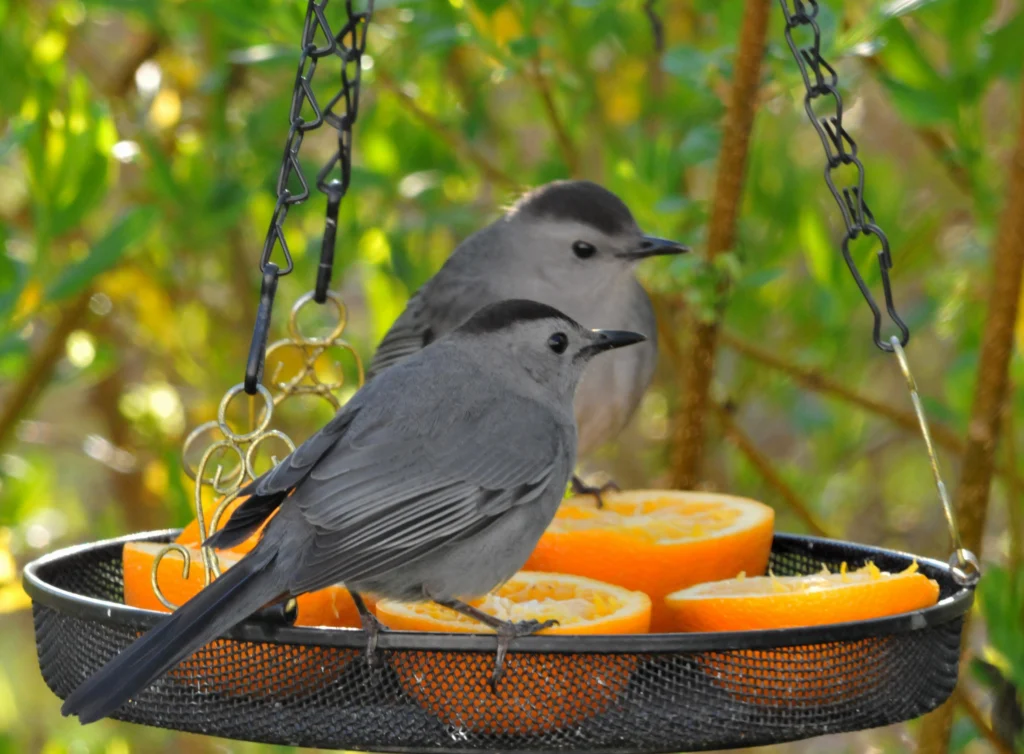
gray catbirds
The heavens of the suburban gardens and parklands echo with a peculiar, yet enchanting melody. A symphony that can make one believe they’re in an enchanted forest, brimming with a myriad of birds singing in unison. The source of this melodic enchantment is none other than the Gray Catbird.
Adorned in a cloak of distinctive gray plumage, the Gray Catbird is a small songbird that holds an orchestra within its tiny body. It carries the name ‘catbird’ not because of any feline characteristics, but due to its unique call that strikingly resembles a cat’s meow. But don’t be fooled by this name, for the Gray Catbird is an accomplished mimic; it can imitate the songs of other birds with astonishing accuracy, adding to the rich tapestry of sounds that fill our gardens and parks.
“They are a common sight in suburban gardens and parklands, where they can often be heard before they are seen.”
As you stroll through the park on a quiet afternoon, don’t be surprised if you hear the call of a bird you can’t see. Look closely, and you might spot the Gray Catbird, quietly perched, filling the air with its melodious charm. Unlike the solitary Gray Heron or the aquatic Gray Seal, our songbird finds its home amidst the hustle and bustle of suburban life, showcasing yet another facet of the diverse lifestyles of grey animals.
In the grand orchestra of nature, each creature plays its part. As we continue our exploration of fascinating grey animals, remember the Gray Catbird, the little songbird with a big voice.
11. Gray Tree Frog: The Color-Changing Amphibian

gray tree frog
As we continue our journey through the world of grey animals, we come across a nimble and versatile amphibian endowed with an intriguing trait — the ability to change its color. Meet the Gray Tree Frog, a small yet fascinating creature native to the lush landscapes of North America.
Unlike the Gray Seal that navigates the vast ocean or the Gray Catbird with its melodious call, the Gray Tree Frog has a different trick up its sleeve. This little amphibian has the remarkable ability to transform its hue to various shades of gray, perfectly camouflaging with tree bark and leaves. This color-changing talent is not just a remarkable sight to behold but a key survival strategy in the wild.
Despite their small size, Gray Tree Frogs are known for their loud, musical call. This enchanting melody, often heard during warm, rainy nights, announces the beginning of their breeding season. It’s a sound that captures the essence of their habitat, echoing through backyards, forests, and wetlands of Eastern North America.
Equipped with adhesive pads on their toes, these nimble climbers skillfully navigate a wide variety of surfaces, from the tallest trees to human-made structures in suburban environments. Their adaptability showcases the resilience of nature and the profound versatility of grey animals.
But the Gray Tree Frog’s significance stretches beyond its color-changing abilities and enchanting call. These amphibians play a crucial role in their ecosystem, controlling insect populations and maintaining biodiversity. By doing so, they remind us of the intricate and delicate balance of our natural world.
So the next time you hear a musical call on a warm, rainy night, remember the remarkable Gray Tree Frog, a small creature with a big role in our colorful ecosystem.
12. Gray-headed Flying Fox: The Majestic Marauder of the Skies
Our final journey in this exploration of the grey animal kingdom takes us to the captivating landscapes of Australia, home to the awe-inspiring Gray-headed Flying Fox. This creature, also known as the large-winged bat, is an emblem of the Australian night sky. With a wingspan stretching up to 1 meter, it’s no wonder that the sight of these beings in flight can be both fascinating and intimidating.
Don’t let their somewhat daunting appearance mislead you. These creatures, cloaked in a luxurious coat of grey fur, are more than just the silent specters of the night. They play a crucial role in maintaining the health of their ecosystems. As they embark on their nightly forays, they engage in the vital tasks of pollinating flowers and dispersing seeds. These nocturnal nomads are primarily frugivores, feeding on a diet rich in fruit and nectar.
Despite their somewhat intimidating appearance, these creatures play a vital role in their ecosystems, pollinating flowers and dispersing seeds as they feed on nectar and fruit.
From their unique feeding habits to their impressive flight capabilities, the Gray-headed Flying Fox is a testament to the adaptability and diversity of grey animals in nature. They embody the resilience and determination that all these animals share, thriving in their respective habitats despite the challenges they face.
The animal kingdom is a tapestry of biodiversity, and our exploration of these twelve fascinating grey animals, from the majestic elephants to the melodious gray catbirds, and now, the large-winged bats, showcases the richness of this spectrum. It’s a reminder of our responsibility, as stewards of the Earth, to ensure these creatures continue to flourish in their natural habitats for generations to come.
Some fascinating grey animals include elephants, gray wolves, gray whales, gray squirrels, gray foxes, gray langurs, gray herons, gray seals, gray catbirds, gray tree frogs, gray reef sharks, and gray-headed flying foxes.
African Bush Elephants are the largest land mammal on Earth with distinct greyish-brown skin. They have large, fan-like ears to dissipate heat and long, curved tusks for foraging and defense. They are herbivores and play a crucial role in shaping their environment by dispersing seeds through their droppings. However, they face threats from habitat loss and ivory poaching.
Grey Foxes, scientifically known as Urocyon cinereoargenteus, are found in North and Central America. They have grizzled grey fur with patches of cinnamon, white, and black. Grey Foxes are well-adapted to blend into various habitats and are one of the only canids with the ability to climb trees. They are omnivorous and play an important role in controlling pest populations.
Gray Tree Frogs can change their color to blend in with their surroundings. They are found in wetlands, forests, and backyards of Eastern North America. Gray Tree Frogs have a loud, musical call during their breeding season and have adhesive pads on their toes for climbing. They help control insect populations and are sensitive to pollutants and climate changes.

